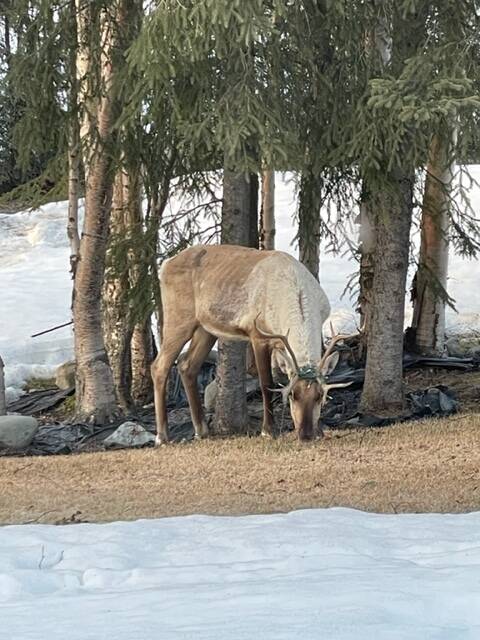As the sun comes out and the snow melts away, wildlife are making more regular appearances on the Kenai Peninsula, and officials want to remind people about the best practices for staying safe outside.
Nick Fowler, the area biologist for the Kenai Peninsula with the Alaska Department of Fish and Game, said in an interview Monday that every year the agency gets calls from residents about animals either in distress or involved in a disturbance.
One Soldotna resident, Robin Andree, for example, recently saw a caribou with outdoor holiday lights tangled in its antlers and notified Fish and Wildlife.
Fowler said this isn’t necessarily out of the ordinary.
“It kind of varies by season,” he said. “It’s not uncommon to get clothesline or Christmas lights, (or) really you name it. I think in the last 10 or 15 years someone’s probably seen it, from a swingset to a ladder that a moose is carrying around.”
The protocol is pretty simple: Don’t approach wildlife and call the ADFG.
Andree, who contacted the Clarion via email, notified authorities at the Fish and Wildlife division and said she was asked serveral questions about the welfare of the animal. Specificaly, if the lights were hampering the caribou’s vision and if it was prevented from eating. Andree said neither was the case.
“Folks report that sort of stuff, we follow up on it,” Fowler said.
If there is a safe opportunity to take a photo of the animal, that could also be helpful, he said. But in general, Fowler said not to approach wildlife.
Fowler reiterated that wildlife sightings might become more prevalent in the coming weeks, as moose start to birth their calves and bears emerge from their dens, and to prepare accordingly.
“It’s a good time to get the winter bird feeders down, start being more diligent about putting trash out only that morning (and) getting that trash can back in, disposing of those fish carcasses appropriately,” Fowler said.
Not just moose, but also bears can be aggressive this time of year.
“All of Alaska is bear country,” Fowler said. “With that comes the responsibility of living in bear country.”
While recreating especially, he suggested that having a redundant plan of deterrence for bears is key. That means layering protection — whether that be wearing bear bells, carrying bear spray or a firearm, making sure to recreate in groups, or any combination.
“The most effective form of a bear deterrent is the one that you’re most comfortable using,” Fowler said.
He said both on the trails and just outside the home people should minimize potential bear attractants and make their presence known by making noise.
“If you’re not seeing bears while you’re out recreating, that’s the system working,” Fowler said.
Remaining aware of potential risks and how to minimize them is key, he said.
“The best way that we can stop any of these negative human wildlife interactions is to keep them from happening in the first place,” Fowler said.
To file a report, the Soldotna ADFG office can be reached at 907-262-9368. Additionally, reports can be made at http://www.adfg.alaska.gov.
Reach reporter Camille Botello at camille.botello@peninsulaclarion.com. This story has been updated with additional information.

